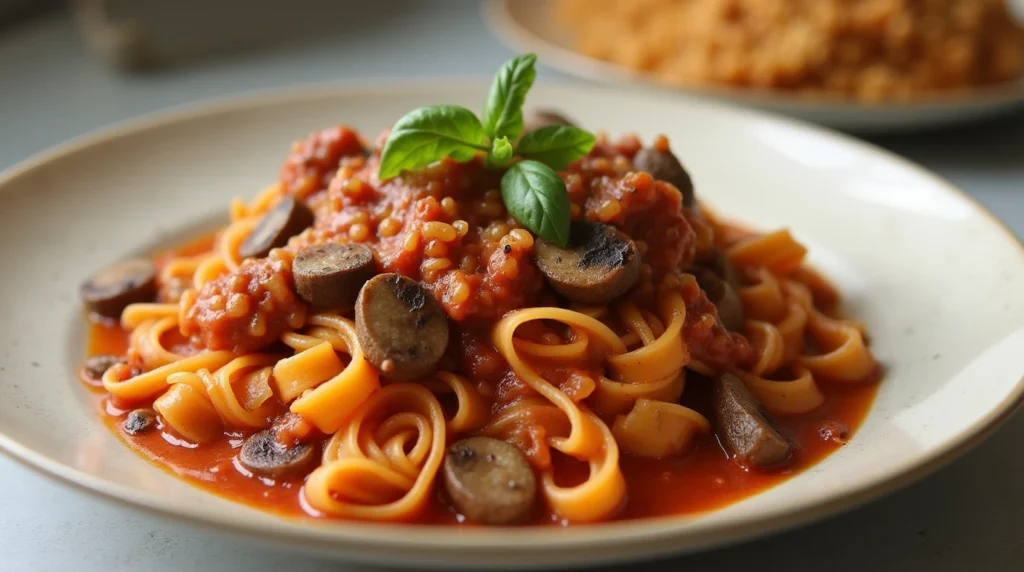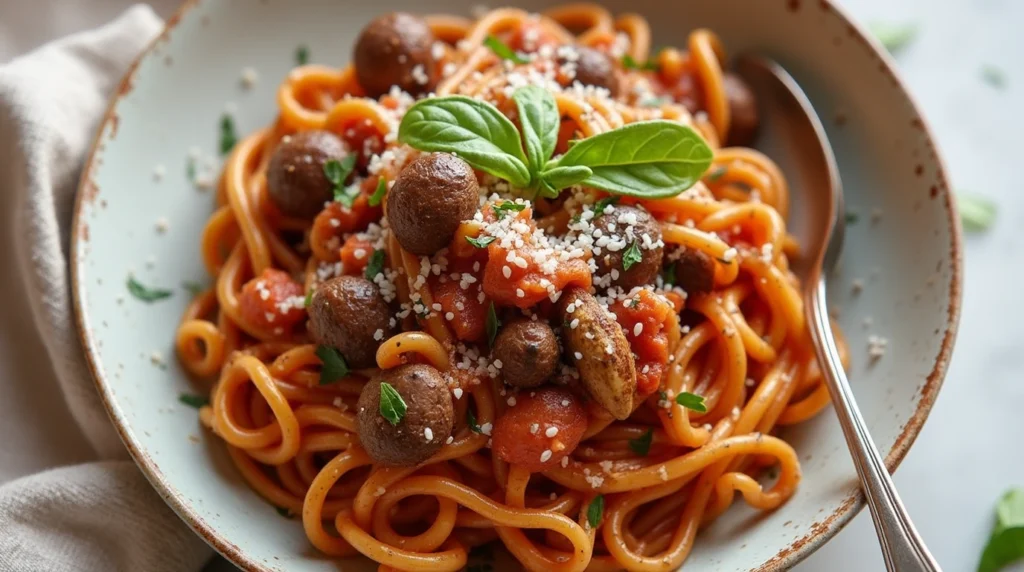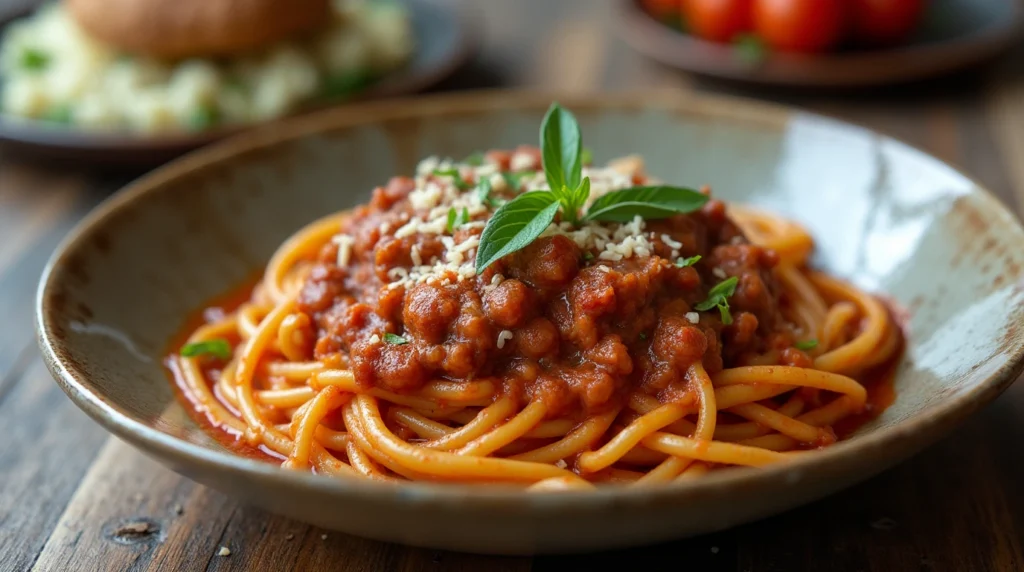Introduction

Mushroom ragu has become a culinary sensation, capturing the hearts—and taste buds—of food enthusiasts worldwide. But if you’re embracing a vegetarian lifestyle, one question often arises: Is mushroom ragu vegetarian? As someone who once stood in the aisle of a grocery store wondering whether that jarred sauce was truly plant-based, I understand how confusing it can be. Let me assure you, understanding the ingredients and preparation methods will empower you to enjoy this savory dish without compromising your dietary choices.
For those following a vegetarian diet, knowing what goes into your meals is crucial. Whether you’re cooking at home or purchasing ready-made sauces, being informed ensures you stay true to your values while savoring delicious flavors. In this comprehensive guide, we’ll delve deep into everything you need to know about mushroom ragu—from its origins to mouthwatering recipes.
What Is Mushroom Ragu?
Definition of Mushroom Ragu
Ragu, originally an Italian staple, traditionally features slow-cooked meat simmered in rich tomato sauce. However, modern adaptations have given rise to mushroom ragu , where earthy fungi take center stage. This plant-based alternative swaps out animal products for mushrooms, creating a hearty, flavorful sauce perfect for pasta lovers everywhere.
Key points:
- Traditional ragu includes meats like beef or pork.
- Mushroom ragu uses vegetables and fungi as the primary protein source.
- It mimics the texture and depth of traditional ragu through careful ingredient selection.
Key Ingredients in Mushroom Ragu
To craft a delectable mushroom ragu, certain staples are non-negotiable. Here’s what you’ll typically find:
- Tomatoes : Fresh or canned tomatoes form the base of the sauce.
- Onions and Garlic : These aromatics add layers of flavor.
- Portobello Mushrooms : Known for their robust texture and umami kick.
- Herbs and Spices : Basil, oregano, thyme, and bay leaves elevate the dish.
Optional additions include nutritional yeast for cheesiness or coconut milk for creaminess.
Origins of Ragu in Italian Cuisine
Ragu finds its roots in Italy, particularly regions like Emilia-Romagna and Tuscany. While classic versions emphasize meat-heavy preparations, vegetarians in these areas have long embraced creative alternatives. For instance, Tuscany’s emphasis on seasonal produce aligns perfectly with mushroom-based dishes.
Fun fact: Italians refer to ragu as “ragù alla bolognese,” highlighting its Bologna origins.
Why Choose Mushroom Ragu Over Meat-Based Varieties?
Switching to mushroom ragu offers numerous advantages:
- Health Benefits : Lower fat content and higher fiber make it ideal for balanced diets.
- Environmental Impact : Plant-based foods reduce carbon footprints significantly.
- Ethical Considerations : Aligns with cruelty-free eating principles.
Chefs like Jamie Oliver frequently champion vegetarian options, proving they don’t sacrifice flavor.
Is Mushroom Ragu Always Vegetarian?
Common Non-Vegetarian Ingredients in Store-Bought Sauces
Not all pre-made sauces marketed as “mushroom ragu” are vegetarian-friendly. Watch out for hidden culprits such as:
- Gelatin (derived from animal bones).
- Fish-based seasonings like anchovies.
- Dairy products like butter or Parmesan cheese.
How to Check Labels for Vegetarian-Friendly Options
When shopping, scrutinize labels carefully:
- Look for certifications like the Vegan Society logo.
- Avoid ambiguous terms like “natural flavors.”
- Opt for trusted brands like Rao’s Homemade or Barilla Veggie Pastas.
Can Vegans Eat Mushroom Ragu Too?
Absolutely! By omitting dairy entirely, you can create a fully vegan version. Substitutes include:
- Nutritional yeast instead of Parmesan.
- Coconut milk or cashew cream for richness.
DIY vs Pre-Made: Which Is Better for Vegetarians?
Both options have merits:
| Option | Pros | Cons |
|---|---|---|
| DIY | Customizable; no hidden ingredients | Requires time and effort |
| Pre-Made | Convenient; quick meal solution | May contain questionable items |

Health Benefits of Eating Mushroom Ragu
Nutritional Value of Mushrooms
Mushrooms pack a powerful punch when it comes to nutrients:
- Rich in vitamins B and D.
- High in antioxidants like selenium.
- Low in calories but high in fiber.
Low-Calorie Alternative to Traditional Ragu
By swapping meat for mushrooms, you slash calorie counts dramatically. A single serving of mushroom ragu contains fewer than 200 calories, making it perfect for weight-conscious eaters.
Supporting Heart Health with Plant-Based Foods
Studies show that plant-based diets lower cholesterol levels and improve cardiovascular health. Incorporating mushroom ragu into your routine supports this lifestyle shift.
Source: Journal of Nutrition
Boosting Immunity Through Mushrooms
Certain varieties, like shiitake and maitake, contain beta-glucans known to enhance immune function. Adding them to your ragu boosts overall wellness.
Delicious Mushroom Ragu Recipes to Try
Classic Mushroom Ragu Recipe
Let’s start with a beginner-friendly option:
Ingredients Table:
| Item | Quantity | Notes |
|---|---|---|
| Portobello Mushrooms | 500g | Chopped finely |
| Olive Oil | 2 tbsp | Extra virgin preferred |
| Onions | 1 medium | Finely diced |
| Garlic | 2 cloves | Minced |
| Canned Tomatoes | 400g | Crushed |
| Tomato Paste | 2 tbsp | Optional |
| Herbs | To taste | Basil, oregano, thyme |
Instructions:
- Sauté onions and garlic until translucent.
- Add mushrooms and cook until golden brown.
- Stir in tomatoes and herbs; let simmer for 30 minutes.
Creamy Vegan Mushroom Ragu Without Cream
Achieve lusciousness without dairy:
Key Substitutions:
- Blend soaked cashews with water for creaminess.
- Use coconut milk sparingly for richness.
Gluten-Free Mushroom Ragu Option
Pair your sauce with gluten-free alternatives like quinoa pasta or zucchini noodles for a grain-free twist.
Quick Weeknight Mushroom Ragu Idea
Short on time? Simmer pre-chopped mushrooms with marinara sauce for a speedy yet satisfying meal.
Tips for Making Your Mushroom Ragu Stand Out
Experimenting with Different Types of Mushrooms
Don’t limit yourself to portobellos alone. Mix in cremini, shiitake, or even wild mushrooms for complex flavors.
Adding Herbs and Spices for Extra Flavor
A pinch of red pepper flakes adds heat, while fresh basil lends brightness. Don’t shy away from experimenting!
Pairing Wines with Mushroom Ragu
For wine enthusiasts, try pairing your dish with full-bodied reds like Chianti or lighter whites like Pinot Grigio.
Serving Suggestions Beyond Pasta
Think outside the box: serve over polenta, stuffed in peppers, or atop bruschetta.
The Science Behind Mushroom Ragu’s Flavor Profile
Umami: The Secret Ingredient
Mushrooms are renowned for their umami-rich flavor, which makes them a perfect substitute for meat in ragu. Umami, often referred to as the “fifth taste,” provides a savory depth that satisfies cravings typically associated with animal proteins.
Key points:
- Mushrooms contain glutamates, compounds responsible for umami.
- Cooking techniques like roasting or caramelizing enhance umami further.
- Combining mushrooms with tomatoes amplifies this effect due to shared amino acids.
How Texture Influences Perception
Texture plays a pivotal role in how we perceive food. Portobello mushrooms, when cooked properly, mimic the chewiness of ground meat. This similarity contributes to mushroom ragu’s appeal among both vegetarians and non-vegetarians alike.
Tip: To achieve optimal texture, slice mushrooms thickly before sautéing to prevent them from becoming overly soft.

Mushroom Varieties for Your Ragu
Portobello Mushrooms
These large, meaty fungi are the go-to choice for mushroom ragu. Their dense structure holds up well during cooking, ensuring a satisfying bite.
Cremini Mushrooms
Also known as baby bellas, cremini mushrooms offer a milder flavor compared to portobellos. They work beautifully in blends to balance stronger tastes.
Shiitake Mushrooms
Native to East Asia, shiitakes bring a woodsy aroma and intense umami notes to your sauce. Rehydrate dried shiitakes for added complexity.
Oyster Mushrooms
Delicate yet flavorful, oyster mushrooms add a velvety texture to ragu. Use sparingly to complement other varieties without overpowering the dish.
Cultural Adaptations of Mushroom Ragu
Italian Influence on Vegetarian Cuisine
Italy’s culinary tradition celebrates seasonal ingredients, making it a natural fit for vegetarian adaptations. Many regions already incorporate plant-based elements into classic recipes, paving the way for innovations like mushroom ragu.
Fun fact: In Tuscany, ribollita , a hearty vegetable soup, showcases how simple, locally sourced produce can create unforgettable meals.
Global Takes on Mushroom-Based Sauces
Beyond Italy, cultures worldwide embrace fungi in their cuisines. For instance:
- Japanese : Miso-mushroom stews highlight fermentation’s role in enhancing flavor.
- French : Duxelles, a finely chopped mushroom mixture, forms the base of elegant sauces.
- Chinese : Stir-fried mushrooms paired with soy sauce create umami-packed dishes.
Inspired by these traditions, you can experiment with international spices and methods to give your mushroom ragu a unique twist.
Troubleshooting Common Issues
Why Does My Mushroom Ragu Taste Watery?
Excess moisture is a common issue when cooking mushrooms. Here’s how to fix it:
- Pat mushrooms dry before cooking to remove surface water.
- Cook mushrooms separately until they release and evaporate juices.
- Thicken the sauce using tomato paste or cornstarch mixed with water.
How Do I Prevent Mushrooms from Turning Mushy?
Proper preparation prevents unwanted textures:
- Avoid overcrowding the pan; cook in batches if necessary.
- Increase heat initially to sear mushrooms, locking in moisture.
- Don’t stir too frequently, allowing them to develop a golden crust.
Storing and Reheating Mushroom Ragu
How Long Does Mushroom Ragu Last?
Properly stored, mushroom ragu remains fresh for up to five days in the refrigerator. Freeze portions for longer shelf life, ensuring they stay good for several months.
Tips for Reheating Without Losing Flavor
Reheat gently to preserve texture and taste:
- Use low heat on the stove or microwave at intervals.
- Add a splash of water or broth to rehydrate any dried-out areas.
- Stir occasionally to distribute heat evenly.
Creative Ways to Enhance Your Mushroom Ragu
Incorporating Nuts and Seeds
Adding nuts or seeds introduces crunch and nutritional benefits. Try:
- Toasted pine nuts sprinkled over the finished dish.
- Ground almonds blended into the sauce for creaminess.
Leveraging Fermented Ingredients
Fermented products deepen flavors naturally:
- A spoonful of miso paste adds saltiness and umami.
- Capers or olives provide briny accents reminiscent of anchovies.
Community Insights and Testimonials
What Real Users Say About Mushroom Ragu
Feedback from home cooks highlights the versatility and satisfaction of mushroom ragu:
- “I was skeptical at first, but this recipe blew me away!” – Sarah L.
- “Even my carnivorous husband loved it!” – Mark T.
Encourage readers to share their experiences in the comments section below.
Mushroom Ragu and Its Role in Modern Diets
The Rise of Plant-Based Eating
In recent years, plant-based diets have gained immense popularity due to increased awareness of health, environmental sustainability, and ethical concerns. Mushroom ragu fits seamlessly into this trend, offering a nutritious and flavorful alternative to traditional meat-based sauces.
Key statistics:
- According to a report by Grand View Research , the global plant-based food market is projected to grow at a CAGR of 11.9% from 2022 to 2030.
- A survey conducted by Vegetarian Times revealed that 7.3 million Americans follow a vegetarian diet, with many more adopting flexitarian lifestyles.
How Mushroom Ragu Supports Flexitarianism
Flexitarians, who occasionally include animal products in their diets, benefit greatly from dishes like mushroom ragu. It allows them to enjoy familiar flavors without committing fully to vegetarianism.
Tip: Start by replacing half the meat in your favorite ragu recipe with mushrooms to ease into plant-based cooking.
Nutritional Breakdown of Mushroom Ragu
Macronutrient Composition
Mushroom ragu provides a balanced mix of macronutrients essential for a healthy diet:
- Protein : Mushrooms contribute modest amounts of protein, complemented by legumes or nuts if added.
- Carbohydrates : Tomatoes and pasta supply energy-rich carbs. Opt for whole-grain options for added fiber.
- Fats : Healthy fats come from olive oil and optional nut-based creams.
Micronutrient Powerhouse
This dish is packed with vitamins and minerals crucial for overall well-being:
- Vitamin D : Certain mushrooms, especially those exposed to sunlight, contain vitamin D.
- Iron : Cooked tomatoes enhance iron absorption thanks to their high vitamin C content.
- Zinc : Crucial for immune function, zinc is present in mushrooms and fortified ingredients.

Mushroom Ragu as a Family-Friendly Dish
Introducing Kids to Vegetarian Cooking
Getting children involved in preparing mushroom ragu can foster lifelong appreciation for plant-based foods. Assign age-appropriate tasks such as washing vegetables or stirring the sauce.
Fun fact: Mushrooms’ earthy flavor pairs exceptionally well with sweet elements like caramelized onions, making it appealing even to picky eaters.
Hosting Vegetarian Dinner Parties
Impress guests with a hearty mushroom ragu served alongside crusty bread or garlic knots. Customize portions based on dietary preferences, ensuring everyone feels included.
Sustainability and Ethical Considerations
Environmental Impact of Plant-Based Foods
Choosing mushroom ragu over meat-based alternatives significantly reduces your carbon footprint. Producing one kilogram of beef generates approximately 60 kg of CO₂, whereas growing mushrooms emits less than 1 kg of CO₂ per kilogram.
Actionable step: Support local farmers and organic producers whenever possible to minimize transportation emissions.
Cruelty-Free Living Made Easy
By embracing mushroom ragu, you align with cruelty-free values while enjoying delicious meals. Share your commitment with friends and family through social media or community events.
Expert Insights and Inspirations
Chef Recommendations
World-renowned chefs often share their take on mushroom ragu, proving its versatility across cuisines. For instance:
- Mario Batali : Known for his love of Italian cuisine, Batali frequently highlights vegetarian adaptations in his cookbooks.
- Yotam Ottolenghi : This Middle Eastern chef incorporates bold spices and herbs into his mushroom-based recipes, inspiring innovation.
Influencer Endorsements
Social media personalities like @minimalistbaker and @ohsheglows regularly post mushroom ragu recipes, showcasing how easy and satisfying they can be. Follow their accounts for inspiration and tips.
Common Myths About Mushroom Ragu
1: Mushroom Ragu Lacks Flavor
Fact: With proper seasoning and ingredient selection, mushroom ragu rivals any meat-based sauce in terms of taste. Experiment with smoked paprika or truffle oil for an extra kick.
2: It’s Difficult to Make
Fact: Mushroom ragu requires minimal effort compared to traditional ragus, which involve hours of slow-cooking. Most recipes are ready within 30-45 minutes.
3: Only Portobellos Work
Fact: While portobellos are popular, other varieties like cremini, shiitake, and oyster mushrooms add unique textures and flavors. Don’t limit yourself—mix and match for best results.
Advanced Techniques for Mastering Mushroom Ragu
Deglazing the Pan
After sautéing mushrooms, deglaze the pan with wine or vegetable broth to capture concentrated flavors. This technique elevates your sauce exponentially.
Incorporating Fresh Herbs
Adding fresh herbs at different stages enhances complexity:
- Early: Bay leaves and thyme infuse subtle notes throughout cooking.
- Late: Basil and parsley brighten the final dish just before serving.
Seasonal Variations of Mushroom Ragu
Spring Edition
Celebrate spring with lighter ingredients like asparagus and peas, blending them into your ragu for freshness.
Autumn Harvest
Embrace fall with roasted root vegetables and wild mushrooms, creating a cozy, comforting meal perfect for cooler weather.
FAQ Section
Q: Is mushroom ragu vegetarian?
A: Yes, provided it doesn’t contain animal-derived ingredients like gelatin or dairy. Always check labels or prepare it yourself for peace of mind.
Q: Can vegans enjoy mushroom ragu?
A: Absolutely! Simply avoid dairy and opt for plant-based substitutes.
Q: Are all store-bought mushroom rags vegetarian?
A: No, some may include hidden animal products. Always read the fine print.
Conclusion
In summary, mushroom ragu is not only vegetarian but also a versatile, nutritious, and delicious choice for anyone looking to embrace plant-based eating. From mastering homemade recipes to navigating store shelves, armed with knowledge, you can confidently incorporate this dish into your repertoire. So go ahead—experiment, personalize, and relish
